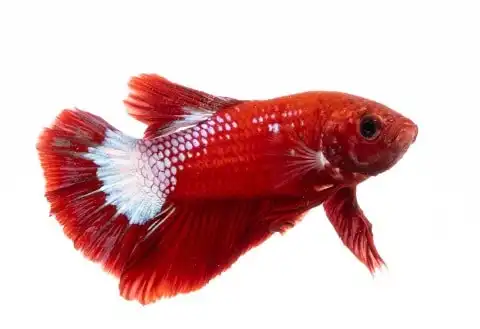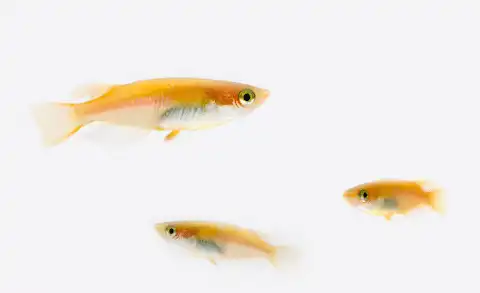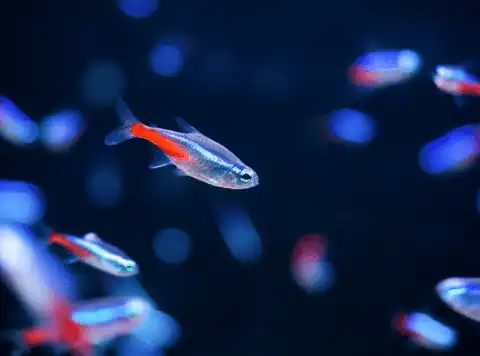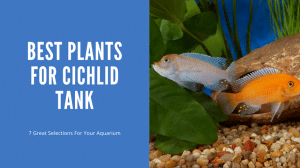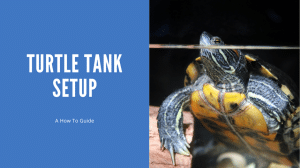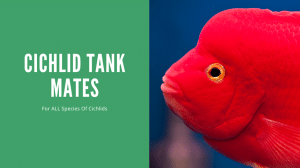Thank you for visiting! By the way… any links on this page that lead to products on Amazon and other stores/partners are affiliate links Aquarium Store Depot earns a commission if you make a purchase.
Are you considering buying a 1-gallon fish tank? A compact aquarium is an attractive idea for many fishkeepers, but such a small tank is not a wise choice for a beginner.
Read this article to explore the potential uses for a 1-gallon fish tank and learn why there are no suitable fish for 1 gallon tank setups. Let’s dive in!
Key Takeaways
- A 1 gallon fish tank or bowl is too small to keep live aquarium fish long-term. They may survive, but they will not thrive in such a cramped space.
- It is possible to keep nano fish like bettas in a 1-gallon tank as a temporary solution, although you need to keep a close eye on water parameters and perform frequent water changes. A heavily planted small tank will help you maintain stable water parameters.
- Experienced aquarists may attempt to keep fish in micro aquariums, but there’s no good reason to attempt this with live animals. A 5-gallon tank is the minimum recommended size for a fish tank, although larger tanks in the 15 to the 20-gallon range are better for beginners.
- Live plants are a better choice for a 1 gallon tank, although small snail species and ghost shrimp or neocaridina/ red cherry shrimp can also be kept in small tanks.
Can You Keep Fish in a 1 Gallon Tank?
Before we go into too much detail, let’s start off with the big question — Can fish live in a one-gallon tank? The simple answer is yes, but as you’ll learn, there’s a lot more to this question than a simple yes or no.
The next question we need to ask is, should fish live in a one-gallon tank, and the answer is no, at least not in the long term.
Read on as we explore some of the reasons why such a small tank is just not enough space for pet fish.
The Natural Habitat Debate
Sure, many fish live in very small ponds in nature. Betta fish are known to survive in shallow ditches, and some killifish even complete their entire lifecycles in large rain puddles!
However, even the smallest of these ponds and puddles are much larger than a gallon. Shallow freshwater ecosystems are also usually well-vegetated and complete with organisms that help to maintain water quality. Recreating a functional ecosystem is possible in aquariums but very difficult in a micro setup.
Aquarium Size and Swimming Space
One-gallon fish tanks measure about 8 inches long, 6 inches wide, and about 5 inches tall (20x15x13cm). 1-gallon bowls are more common than tanks, and these typically have a diameter of about 8 inches.
That’s really not a lot of space for a fish to swim, so immediately, you run into potential problems for active swimming fish like zebra danios. It’s also important to note that most small fish live in schools or shoals in nature, so it’s best to keep them in groups of six or more.
Hardware And Decorations
Most fish prefer some sort of cover in their tank, like caves where they can hide or plants where they can shelter. However, your space is already pretty limited in a 1-gallon tank, so everything you add to the tank decreases the space for your fish.
The small size of this tank also makes it difficult to find aquarium equipment like heaters and filters.
Water Quality
Maintaining high water quality and stable water parameters is your number-one goal as a fishkeeper. Water quality tends to decrease over time, and at a certain point, fish become sick and even perish in bad water. Now, even large aquariums need regular maintenance, but things can go bad very quickly in a small tank!
As uneaten food and fish waste collects in a fish tank, ammonia accumulates in the water before being converted into nitrite and then nitrate. Ammonia and nitrite are highly toxic to fish, so without a functioning colony of beneficial bacteria in a properly cycled tank, your pets are likely to get sick.
It is possible to cycle a micro aquarium, but such a small tank would be in a delicate balance and very sensitive to increased nutrient levels and other disturbances.
What Can You Keep in a Small Aquarium?
Many small fish and invertebrates are suitable for small aquariums, although 5 gallons is the smallest you want to go for long-term care.
That being said, many species can survive in a 1-gallon tank, but they are not likely to enjoy the experience! That means a 1-gallon setup is usually only recommended as a temporary solution and not as your pet’s forever home.
Nano Species
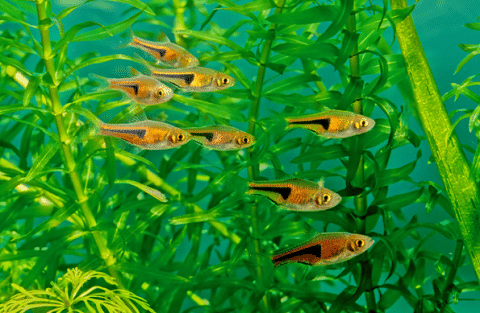
Nano fish are small species, usually growing to less than about 2 inches. The smallest nano species in the fish keeping hobby grow to about 0.75 inches or so, but even larger species like the betta fish are often kept in tiny tanks.
Let’s take a look at a few small fish species and discuss whether they are suitable for a small one-gallon tank.
- Betta Fish
The betta, or Siamese fighting fish, is usually the first choice for fish keepers who want a tiny tank, but a 1-gallon tank is simply too small for an adult betta fish. Sure, these popular fish are often sold in tiny tubs or cups in the aquarium trade, but if you look a little closer, those fish don’t look very happy or healthy!
Use Coupon Code ASDFISH at Checkout
Betta Fish are one of the most beautiful varieties of freshwater fish available in the hobby. Easy to care for with plenty of varieties!
A 5-gallon aquarium with a filter and a heater is a much better long-term solution for betta fish care, and really is the minimum tank size you should consider for these beautiful fish.
- White Cloud Minnows
White cloud mountain minnows are popular cool-water nano fish for smaller tanks. These freshwater aquarium fish max out at about an inch and a half, and their hardy nature makes them a great choice for a beginner.
A very peaceful fish that does well in coldwater fish. Other minnow varieties are also available
However, white clouds are not recommended for tanks smaller than five gallons, and ten gallons is actually their recommended minimum tank size.
- Japanese Rice Fish
Japanese rice fish are a commonly overlooked fish suitable for freshwater aquascapes. Very peaceful and hardy fish that color up with companions
Japanese rice fish, also known as Medaka, are tiny fish that are often kept in small aquariums. Like most other nano fish, they could certainly survive in a tiny one-gallon tank, but it would be very difficult to keep them healthy, and that’s why they’re much better off in a ten-gallon aquarium.
- Neon Tetras
Use Promo Code ASDFLIPPROMO
One of the most popular freshwater community schooling fish available in the aquarium trade. Great neon blue colors!
Neon tetras may be small (up to 1.5 inches), but these stunning schooling fish from South America need a bigger tank than you might think. In fact, 10 gallons is the smallest you’d want to go for these active swimmers, but 15 to 20 gallons is a much better option.
- Least Killifish
The least killifish is a truly tiny creature, and one of the species with the smallest tank requirements in the hobby. Males grow to less than an inch, and females grow a little more than an inch.
A pair of least killifish can be kept in a tank as small as 3 gallons or so, but again, a larger tank in the 5- 10 gallon range would be better.
Invertebrates
Invertebrates (mollusks, crustaceans, etc.) are a popular choice for a smaller aquarium due to their small size and low bioload. Let’s take a look at some popular inverts that can survive in a smaller tank.
- Snails
Snails are popular freshwater aquarium pets that don’t need a huge tank to thrive. However, a 1-gallon tank is a little too small for some species.
You could attempt a 1-gallon setup for small species like bladder snails, but larger aquariums are necessary for bigger species and assassin snails.
- Shrimp
It is possible to keep shrimp in a 1-gallon size tank, but you run the same water quality risks as when keeping fish. A few ghost shrimp could work in a 1-gallon tank with live plants and careful monitoring, but a larger aquarium is always a better bet.
Live Plants
Live aquarium plants are a great option for a small space, and have the added benefit of stabilizing water parameters, which is great if you do need to keep any invertebrates or fish in the tank temporarily.
Many aquarium plants grow too large for a 1-gallon tank or bowl, so make sure you choose miniature species. The following popular aquarium plants are suitable for a small tank:
- Cryptocoryne parva
- Anubias nana petite
- Java moss or Christmas moss
- Bucephalandra spp.
- Red root floater
What To Do With Them?
The question of keeping fish in a 1-gallon tank mostly centers around ethics. Remember, the simple answer is that a small fish will survive in a 1-gallon tank, and maybe even live a full and healthy life if you’re experienced and dedicated enough to perform frequent water quality maintenance.
However, you should also ask yourself why you’re keeping fish in the first place and whether survival is enough or if you want your pets to be as comfortable as possible. Looking at it from this perspective, there are just a few scenarios where you might consider keeping fish in such a small environment.
Read on to learn when you could keep fish in a one-gallon aquarium and discover alternative options for your tiny tank.
Connect Multiple Aquariums
There is one scenario that would theoretically allow you to keep a few species permanently in 1-gallon aquariums, but this is something only experienced aquarists should attempt.
Without going into too much detail, it is possible to plumb multiple tanks together and use a central sump system to pump water through all of them. Ten one-gallon tanks connected would allow you to keep multiple small tanks with small fish while having a better chance of maintaining good water parameters.
It’s important to remember that each fish will still be confined to its own tank, so this is only a good option for the smallest nanofish and species that do not need much swimming space. You’ll also need excellent filtration to maintain good water quality, and some live plants will also help to stabilize the system.
Possible species for a multiple-tank setup include:
- Nano Boraras species like chili and exclamation point rasboras
- Celestial pearl danios
- Ricefish
- Endler’s livebearers
- Scarlet Badis
- Least Killifish
- Emerald rasbora
Parasites and infections spread easily in this kind of setup, so it’s important to quarantine any fish before adding them to the system. This usually involves keeping new fish in a separate cycled tank for three or four weeks to observe their condition and medicate if necessary.
Temporary Housing
It’s always handy to have a spare tank on hand for emergencies. If a new fish in your community tank turns out to be a bully, or if one of the other fish is getting picked on, you may need to move one to a separate tank while considering your options.
Small tanks are also useful for quarantining or medicating sick fish outside of their regular tank. This is especially useful when using medications that are harmful to other animals in a community tank.
You could also use a tiny tank as a temporary housing solution when remodeling one of your larger tanks, but you’ll need to pay close attention to your water parameters and quality. Overfeeding is one of the biggest dangers when moving your fish to a very small tank because excess nutrients from uneaten food can cause rapid changes in water quality.
It is especially important to understand the nitrogen cycle before attempting to keep anything in a small tank, whether it’s a long-term or just a temporary solution. You’ll also need a reliable test kit to monitor your water parameters and develop a water change schedule.
Growing Live Food
A one-gallon tank might be too small for fish, but this tank size is pretty handy for growing your own fish food. Culturing live food is a great idea for feeding picky fish like the scarlet badis and pea puffer.
You could try breeding bladder snails, daphnia, or even mosquito larvae to provide your fish with a free and healthy food source. Just make sure none of those mosquitos escape! Infusoria is a great starter food for fish fry that you can grow in a small tank.
You can also grow algae on rocks if you keep your tank in a sunny area. This is a great natural food source for algae eaters like the otocinclus catfish and some of the Southeast Asian gobies.
Try A Terrarium
You could also try something completely different with a one-gallon fish tank and convert it into a terrarium. Miniature cacti or other succulent plants look great in small glass enclosures, but almost any small plant could survive with the right soil, nutrients, and light.
You’ll still need to water your plants, but they’ll be much easier to care for than live fish in such a tiny space!
FAQs
What fish can live in a one-gallon tank?
Pretty much any small fish can survive in a 1-gallon tank for as long as you can maintain suitable water quality. However, a one-gallon tank is really too small for the long-term care of any fish species, especially if you care about the welfare of your pets.
Can a betta live in a 1-gallon tank?
Betta fish will survive in a one-gallon fish tank, although they will be very cramped and difficult to care for in the long-term. A five-gallon aquarium is the minimum recommended size for a betta fish tank.
How many guppies can live in a 1-gallon tank?
You could keep a single male guppy in a 1-gallon aquarium, although it would be much better to keep a small group of five or six in a decent 15-gallon tank with filtration and heating.
What is the best fish for a small aquarium?
Each fish keeper has their own favorite small fish species, but I do not recommend keeping any freshwater aquarium fish in a tank size smaller than 5 gallons. This tank size will make a great home for bettas and killifish.
Step up to a 15-gallon aquarium to keep even more fish like small tetras, rasboras, and honey gouramis. At this tank size, you can even keep a small community and observe the interesting behavior of happy schooling fish!
Can 2 goldfish live in a 1-gallon tank?
Goldfish need a surprisingly large aquarium for long-term survival. A pair of adult goldfish requires at least 30 gallons, so a 1-gallon tank or bowl just isn’t going to work!
Can snails live in a 1-gallon tank?
Like all aquatic creatures, snails produce waste that can accumulate and affect water quality. Many aquarium snail species are very hardy, but you’d still need to clean their tank regularly and perform a few water changes each week to keep their water quality high. Small species like bladder snails could be an interesting option for a 1-gallon aquarium.
Final Thoughts
Unfortunately, a one gallon aquarium is just too small for keeping fish. However, there are a few things you can do with such a small tank, so don’t be too quick to put your tiny aquarium up for sale! Micro setups are great for growing plants, growing live food, or housing fish for short periods in emergencies.
Do you have a one-gallon aquarium? Let us know what you keep in your tiny tank!
- About the Author
- Latest Posts
I’m thrilled that you found Aquarium Store Depot! Here you’ll find information on fish, aquariums, and all things aquatics related. I’m a hobbyist (being doing this since I was 11) and here to help other hobbyists thrive with their aquariums! I adhere to a high quality Editorial Process and Review products with real life field usage and practical analysis.


